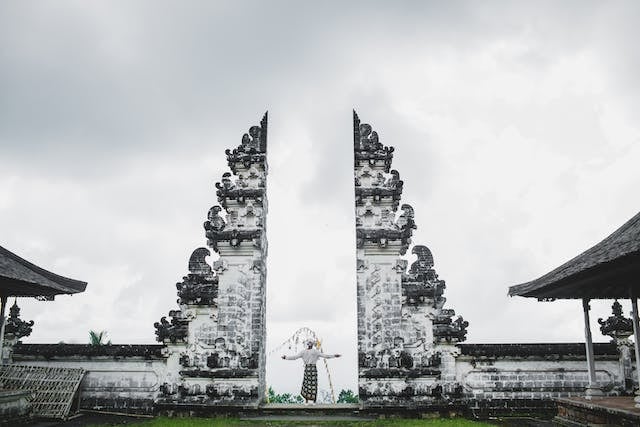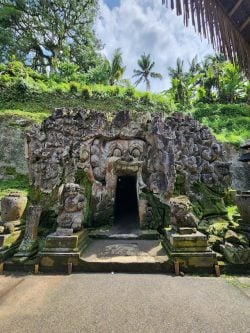The 5 Best Temples in Bali and Why You Should Visit Them
Bali is a place where vibrant culture, lush landscapes, and spiritual serenity converge in a breathtaking tapestry. In this Indonesian paradise, the best temples in Bali stand as timeless witnesses to the island’s rich heritage and deep-rooted spirituality.
Whether they’re close to a paradise beach or perched on active volcanos, each temple is a testament to the island’s unique blend of Hindu-Balinese traditions, and they’re one of the main reasons you why should visit Bali!
Today, we invite you to join us as we explore the best temples in Bali, unveiling the sacred stories and architectural wonders that make each one a cultural gem.
Let the exploration begin!
→Sign Up Now: Free Trial Indonesian Lesson With a Native Teacher!←
1. Tanah Lot Temple
Located in the Beraban village of the Tabanan regency, approximately 20 kilometres northwest of Denpasar, the capital of Bali, Tanah Lot Temple stands as a striking coastal temple situated on Bali’s southwest coast. Positioned on a substantial offshore rock, it gives the illusion of floating on the water, particularly during high tide.
Dedicated to the sea gods, this temple holds significant religious importance for the Balinese people. It serves as a prominent pilgrimage destination. Beyond its spiritual and cultural significance, Tanah Lot Temple is renowned for its captivating vistas, especially as the sun sets, making it one of the best temples in Bali.
Key Highlights of Tanah Lot Temple:
Spiritual Significance: During low tide, visitors traverse to the temple’s base. Here, legendary sea snakes dwell near the Tirta Pabersihan fountain. This unique experience involves receiving blessings from priests and sipping fresh water from the fountain.
Cultural Insight: Onshore temples such as Penyawang and Batu Bolong play crucial roles during high tide, reflecting the agrarian life of the villagers. The pathway, adorned with artisan shops and tropical gardens, provides a glimpse into Tanah Lot’s rich cultural heritage.
2. Lempuyang Temple
Situated atop Bisbis Hill in Tista Village, Lempuyang Temple is famed for the widely recognised Gates of Heaven that have taken over Instagram feeds. The temple complex encompasses several smaller temples, with the primary sanctuary positioned at the highest point of the site.
Lempuyang Temple holds immense importance for Balinese Hindus, serving as both a place of worship and pilgrimage.
Key Highlights of Lempuyang Temple:
The Iconic “Gates of Heaven”: The undeniable star of the show is the iconic “Gate of Heaven,” framing the majestic Mount Agung. This exquisite structure creates a sense of entering a realm of divine beauty, making it a must-see feature of Lempuyang Temple.

A Symbolic Climb: The journey of ascending the 1,700 steps leading to the central Lempuyang Temple symbolises life’s challenges. As pilgrims make their way up, they engage in a process of purification.
3. Ulun Danu Beratan Temple
Ulun Danu Beratan Temple graces the mountainous landscape of Bedugul Regency, perched on a plateau with a commanding view of Lake Beratan.
The temple is dedicated the Hindu goddess Dewi Danu, revered as the goddess of water, lakes, and rivers. It is a water temple located on the shores of Lake Bratan.
Ulun Danu stands out not only for its spiritual significance but also for its breathtaking setting and the refreshing climate of the area. It is one of the best temples in Bali for those who prefer mild temperatures.
Key Highlights of Ulun Danu Beratan Temple:
Enchanting Gardens: As you step into the temple grounds, you’re greeted by a charming garden adorned with vibrant flowers, lush bushes, and towering trees. The harmonious blend of the temple, the lake, and the surrounding mountains creates a visually stunning tableau at Ulun Danu Beratan.
Architectural Marvel: The temple’s architecture is a captivating fusion of Indonesian Balinese design elements, showcasing tiered shrines and other unique features inherent in Hindu architecture.
4. Goa Gajah (The Elephant Cave)
Goa Gajah, also known as the Elephant Cave, is a historical landmark near Ubud, with roots dating back to the 9th century. The site boasts an intricately carved cave entrance adorned with mythological designs, including a prominent statue of Ganesha.
Reflecting a harmonious blend of Hindu and Buddhist influences, it serves as a testament to Bali’s rich cultural and religious diversity, featuring a bathing temple with a ritual pool.
Key Highlights of Goa Gajah:
 Enigmatic Cave Entrance: The gateway to the Goa Gajah cave presents a mesmerising portal that resembles the belly of a rock monster, adding an enigmatic touch to the site and making it one of the best temples in Bali for those who love to take original pictures.
Enigmatic Cave Entrance: The gateway to the Goa Gajah cave presents a mesmerising portal that resembles the belly of a rock monster, adding an enigmatic touch to the site and making it one of the best temples in Bali for those who love to take original pictures.
The Famous Elephant Statue: At the parking area, a weathered concrete statue covered in moss depicts Ganesha, the elephant-headed Hindu god of beginnings.
5. Besakih Temple
Besakih Temple, often recognised as the Mother Temple of Bali. It holds the distinction of being the largest and holiest temple on the island, perched majestically on the slopes of Mount Agung. This expansive temple complex is a spiritual haven, featuring multiple shrines dedicated to various deities within the Hindu pantheon.
Situated in the village of Besakih in eastern Bali, Indonesia, the temple sits at an elevation of 1,000 metres on the southwestern slopes of Mount Agung, which is an active volcano.
Key Highlights of Besakih Temple:
Pura Penataran Agung: Serving as the main temple of the district, Pura Penataran Agung boasts a grand stairway adorned with figures from the Ramayana and Mahabharata. These intricate carvings symbolise the devotion to Shiva, with preserver Vishnu represented in Pura Batu Madeg, and the creator Brahma embodied in Pura Kiduling Kreteg.
Cardinal Temple Complex: Besakih features four distinct temples representing the cardinal directions. Pura Ulun Kulkul stands to the west, Pura Gelap to the east, Pura Madu Batek to the north, and Pura Kiduling Kreteg to the south, creating a sacred space that aligns with the four points of the compass.
Delve Into Indonesia’s Culture and Languages
As we conclude our exploration of the best temples in Bali, we’d love to invite you, our reader, to delve even deeper into the vibrant heritage of Indonesia. Beyond the awe-inspiring landscapes and architectural wonders, Indonesia is a mosaic of languages and cultures waiting to be discovered.
At Language Trainers, we offer not just language courses but tailored learning experiences designed to meet your unique needs.
Whether you prefer the flexibility of online learning or the personalised touch of in-person courses, our offerings are crafted to ensure that your language journey aligns seamlessly with your goals.
Picture this: learning to speak Indonesian in Sydney (or any other city!) from the comfort of your home or engaging in face-to-face sessions that bring the language to life, adapting to your pace and preferences.
→Sign Up Now: Free Trial Indonesian Lesson With a Native Teacher!←
Just as our exploration of the best temples in Bali unravelled stories embedded in the culture, our native teachers infuse your Indonesian lessons with a cultural richness that goes beyond grammar rules. It’s not just about learning words; it’s about understanding the nuances, expressions, and cultural context that make a language truly come alive.
So, what are you waiting for? Contact Language Trainers now and join us in this cultural and linguistic journey, where every lesson is a step closer to a richer, more immersive understanding of Indonesia. Selamat Belajar! (Happy learning!)
